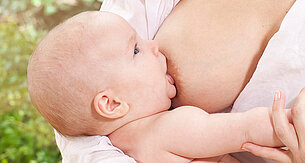First infant milk provides babies who are not or only partially breastfed with all the nutrients they need during this crucial phase of their development.
Bottle-feeding your baby some or all of the time does not mean that you show him or her less love or affection. On the contrary: hold your baby in your arms just like you would during breastfeeding and make sure you hold eye contact during the feed. This way, your baby will not just be full, but also content.
Preparing the feed
Always follow the instructions on the pack when making up a bottle feed. To provide your baby with the optimal balance of nutrients and to ensure that he or she can digest the feed easily, it is important that you stick to the measurements for powder and water that are indicated on the pack. As baby’s immune system has not matured yet, always comply with some basic hygiene rules: prepare the bottle immediately before the feed and not in advance. Your hands, the scoop and all parts of the bottle must be clean and dry. Always boil the water that is used for making up the feed.
Not too hot, not too cold
When feeding your baby, the temperature of the formula should not be higher than 37°C (body temperature). To test whether the temperature is right, squirt a few drops on to the inside of your wrist: the liquid should feel warm, not hot. The amount your baby consumes will vary according to his or her appetite and the time of day. Let your baby drink until he or she is full. Discard any leftovers – formula should not be re-used.
Clean teats, healthy babies
All parts of the bottle and the teat must be cleaned thoroughly after every feed. Rubber teats should be boiled occasionally (this is not necessary for silicon teats). To measure out the powder, always use the scoop provided in the pack. There is no need to rinse or sterilise it. Simply wipe the scoop with a clean kitchen cloth after use and store it in a clean and dry place outside the pack.




